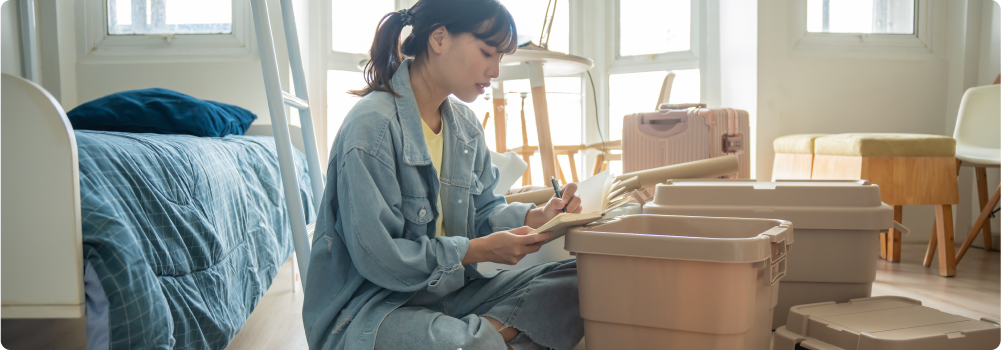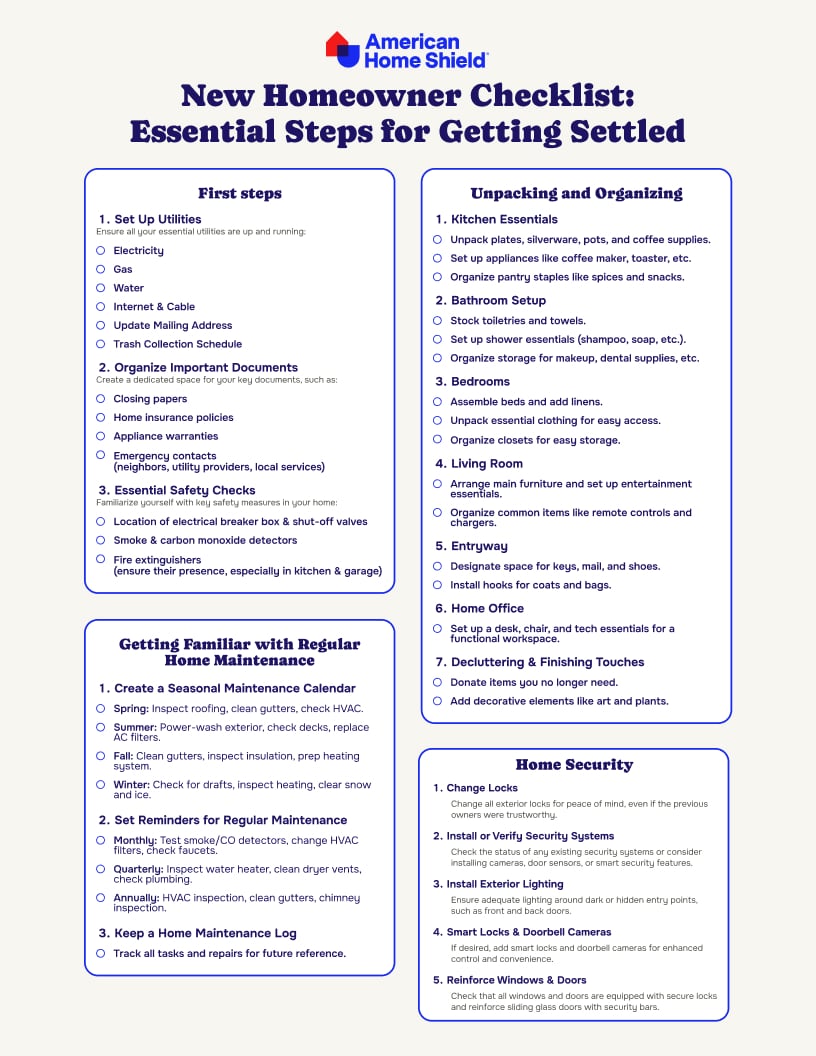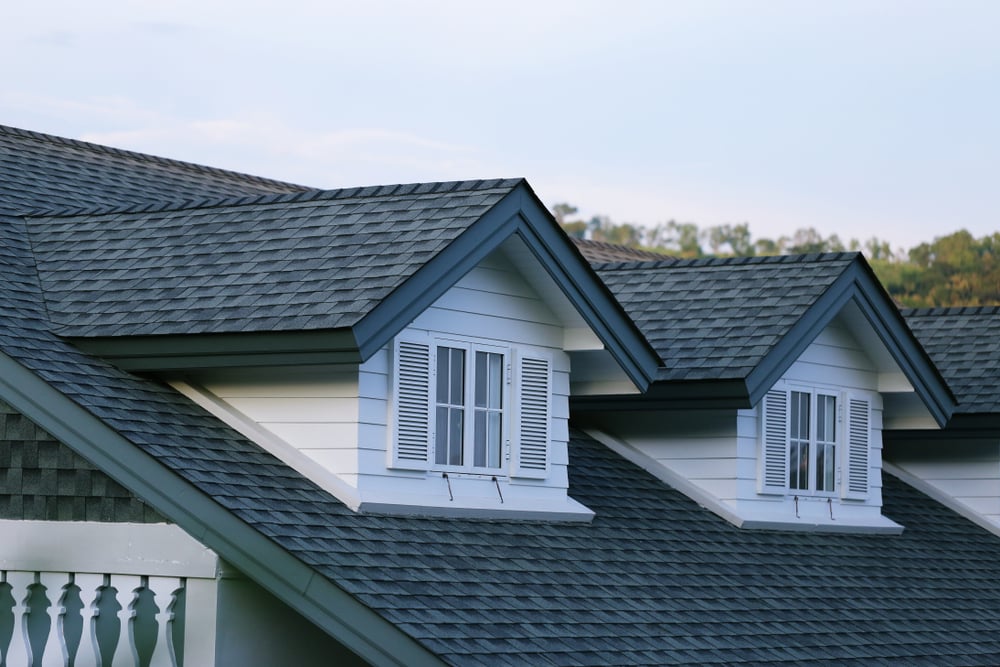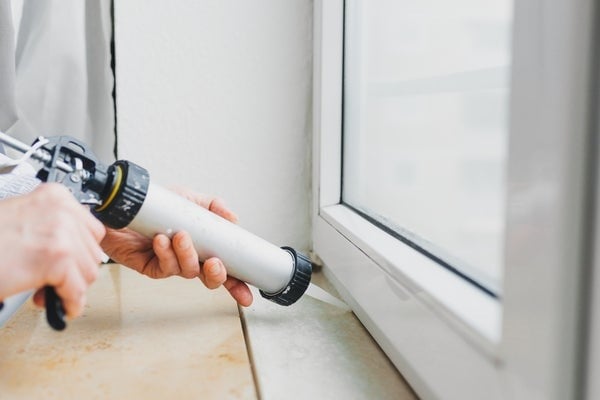First steps for setting up new home
1. Set up utilities
Whether you’re transferring existing plans, filing changes, or starting service anew, make sure that all your essential utilities are up and running before move-in time.
Check your:
- Electricity
- Gas
- Water
- Internet, cable, and phone
- Mailing address update
- Trash collection schedule
2. Organize important documents
In the chaos of being new to your home, there are a few important things that definitely shouldn’t go missing in the commotion. Create a dedicated space, like a binder or digital folder, for all your critical documents. You’ll want to keep closing papers, home insurance policies, and appliance warranties all in one place.
It can also be useful to make a list of emergency contacts, like utility providers, neighbors, and local services, in case you need quick access to resources in the future.
3. Essential safety checks
Performing key safety checks is a new home essential. This helps ensure that you and your home are ready in the case of an emergency. Familiarize yourself with:
- The location of your electrical breaker box and gas and water shut-off valves
- Your smoke and carbon monoxide detectors
- The location of your home’s fire extinguishers (if you don’t already have them, the kitchen and garage are great spots to keep one handy).
4. Home Security
Making your home secure from day one helps you feel more at ease in your new space. Consider these home security measures:
Rekey the Locks: Rekeying your exterior locks is a smart way to ensure you’re the only one with access to your new home, even if the previous owners were trustworthy.
Install or Verify Security Systems: If the home came with a security system, ensure it’s in working order and update any security codes. If not, you might consider installing cameras, door sensors, or a smart home security system.
Exterior Lighting: Install or test existing exterior lights around the front, back, and side doors, especially around dark or hidden entry points.
Smart Locks and Doorbell Camera: If you prefer extra control, consider adding smart locks. These devices allow you to monitor and control access from your phone.
Reinforce Windows and Doors: For additional security, check that all windows and doors are equipped with locks. Reinforce sliding glass doors with a security bar.

Unpacking and organizing
Now that you’re ready to start unpacking, follow our strategic new home checklist to break the process into manageable, efficient chunks.
1. Kitchen essentials
At some point during the move, you’ll need to eat. Making sure the kitchen is at least partially set up allows you to keep on track throughout the unpacking process.
- Unpack Core Essentials: Start with items you use most, like plates, silverware, pots, and coffee supplies. Place these items in easily accessible cabinets and drawers.
- Set Up Basic Appliances: Make sure your coffee maker, toaster, and any go-to appliances are unpacked and plugged in.
- Organize Pantry Basics: Put shelf staples like spices, canned goods, and snacks in designated pantry or cabinet areas. Adding shelf liners can keep these areas tidy and easy to clean.
2. Bathroom setup
Next, set up the bathroom so that everyone can freshen up comfortably.
Stock Toiletries and Towels: Place towels, soap, toilet paper, and other basics in bathrooms that everyone will use.
- Add Shower and Bath Essentials: Set up shampoo, conditioner, body wash, and any other items in the shower or tub so you don’t have to search for them later.
- Organize Storage: Use drawer organizers or small bins for items like makeup, hair products, or dental supplies.
3. Bedrooms
Setting up bedrooms allows you to feel comfortable and like you’re establishing routines as you continue to unpack.
- Assemble Beds and Add Linens: Start by setting up beds in each room and adding sheets, pillows, and blankets.
- Unpack Essential Clothing: Hang or fold the clothes you’ll need for the first few days. This makes it easy to dress without searching through boxes.
- Organize Closets: Take this opportunity to arrange your closet with a system that works for you. Consider using labeled bins for seasonal items or accessories.
4. Living room setup
Once the new home essentials are set up, move on to the living room to create a relaxing space to unwind after unpacking.
- Arrange Main Furniture Pieces: Place the couch, coffee table, and any side tables where they’ll likely stay. This can help you picture the room layout as you unpack smaller items.
- Unpack Entertainment Essentials: Set up the TV, streaming devices, and other entertainment items you’ll want for downtime.
- Organize Common Items: Keep things like remote controls, chargers, and blankets in easy-to-reach spots.
5. Entryway organization
A well-organized entryway establishes a welcoming feeling in your new home.
Create a Drop Zone: Designate a table or shelf near the door for keys, mail, and wallets.
Add Shoe Storage: Place a shoe rack or mat near the door to keep floors clean and organized.
Hang Hooks for Coats and Bags: Having hooks ready for jackets, bags, and umbrellas saves space in closets.
6. Home office
If you work remotely or need a space for bills and paperwork, setting up a home office can help keep work organized and separate from home life.
- Arrange Desk and Chair: Find a spot that’s comfortable and offers enough space to stay focused.
- Organize Office Supplies: Place essentials like pens, chargers, and notebooks within reach. Drawer organizers can help keep things tidy.
- Set Up Tech Essentials: Plug in any computers, monitors, or other tech items you use regularly.
7. Decluttering and finishing touches
Now that each space is set up, it’s time to make everything feel cohesive and truly “yours.”
- Declutter as You Go: If you come across items you don’t need, consider donating them. This keeps your new space free of excess and lets you start fresh.
- Add Decorative Elements: Finally, bring in decorative items like art, throw pillows, and plants to add personality and warmth.




